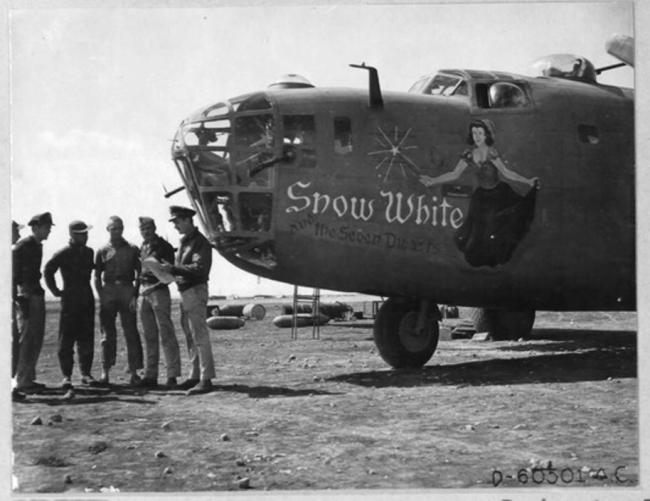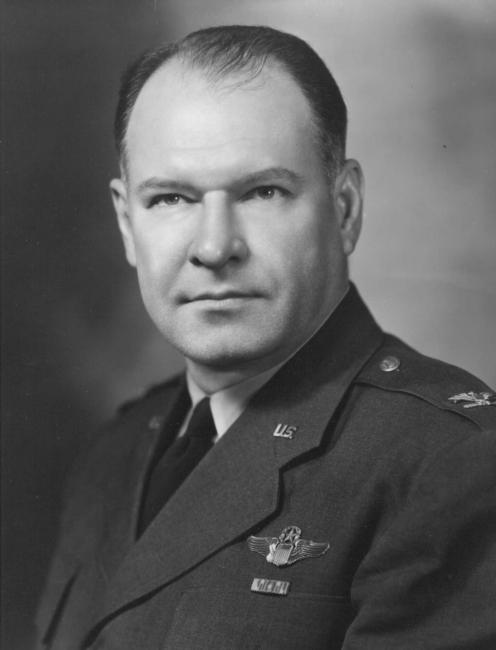John Riley Kane
Military
Removed associations not depicted in the image. Associated content and biographical details should be added to the AIRCRAFT and/or PERSON records.
Object Number - UPL 39792 - Col. John R. Kane was the group leader and command pilot of the B-24D he named, Hail Columbia, named by Kane for Columbia University, with his...
John Riley Kane was a colonel in the United States Army Air Corps and, later, in the United States Air Force. He received the U.S. military's highest combat decoration, the Congressional Medal of Honor, in World War II, for his leadership, courage, and heroism, leading the 98th, the 44th, and the 389th Bombardment Groups on Operation Tidal Wave, the low altitude attack on the oil refineries at Ploesti, Romania. All of the bomb groups that Col. Kane led, successfully bombed their assigned targets, including Kane's target, the Astra Romano Refinery. 1 Aug 43.
A native of Texas, Kane joined the Army Air Corps after graduating from Baylor University. In WWII in July 1942, he was sent to the MTO, the Mediterranean Theatre of Operations, where he flew 43 combat missions against shipping over the Mediterranean Sea and over Italian ports, for a total of 250 combat hours in Africa, the Middle East, and, later, Europe.
In North Africa, John Kane became the Group Commander of the 98th Bombardment Group, named, "The Pyramiders". His aggressive and daring flying on combat missions against the German Army in North Africa caused German intelligence reports to name him, "Killer" Kane, after the movie arch enemy of Buster Crabbe's "Buck Rogers" serial movies.
Kane earned the Silver Star after a mission when his B-24D airplane that he named, Hail Columbia, was attacked from the rear by a German ME-110 fighter. Even though the tail and top turrets of his bomber became inoperative during the air fight, Kane successfully outmaneuvered the pursuing ME-110 through eight different attacks. The German pilot eventually exhausted his ammunition and was forced to break off the attack without causing any appreciable damage to Kane's aircraft.
Kane chose Lt. John Young, a fellow Texan from Dallas to be his copilot in Kane's lead B-24D aircraft for the Ploesti mission, Hail Columbia, including Lt. Young's crew from his personal B-24D, Kickapoo.This last minute change proved fortunate for Young and his regular crewmen when, Kickapoo, lost it's number 4 engine on takeoff for the mission and crashed, killing it's two replacement pilots, Lt. Robert Nespor, Lt. John Riley, and most of the plane's replacement crew, minus two crewmen, who survived being badly burned in the plane's crash and only returned to duty after a long rehabilitation and healing, months later. (2-RTD), 1944. Col. John Kane, Lt. John Young, and all of the crewmen on, Hail Columbia, incredibly, survived the Ploesti mission, escaping the Ploesti area, and flew south and west across neutral Turkey to the Greek island of Cyprus, where they crash landed on the British air base at Nicosia, wrecking, Hail Columbia, which was written off at the base.1 Aug 1943. As Col. Kane and his crew inspected their wrecked B-24, Hail Columbia, in the next morning's daylight, as the crew and Kane were looking over their wrecked B-24, marveling that the big bomber had made it all the way to Cyprus in it's shot up and damaged condition, several of the crewmen reported seeing tears in the normally stoic Col. Kane's eyes, as he looked over his beloved, Hail Columbia, the plane he felt had saved his life more than once, and, likely, thinking of all the men he knew and were lost on the mission. 2 Aug 43. A total of 41 B-24s were lost to enemy defenses, mostly anti-aircraft flak rounds and another seven lost to internment. Another six were lost to varying causes: one crashed on takeoff, his own copilot's regular B-24, Kickapoo, one, Wongo Wongo, flew out of control and crashed into the sea, for no apparent reason, possibly,a runaway autopilot, en route to Ploesti, across the Mediterranean Sea, two in a mid-air collision in clouds on return, one, Kane's own, Hail Columbia, crashed on landing at Cyprus, and another one, Lt. Gib Hadley's, Hadley's Harem, lost power and crashed into the ocean off the Turkish coast. This made for 54 total B-24D losses, with 310 aircrew killed, 108 captured and 78 interned in Turkey. After the Ploesti mission, by August 3rd, after the mission, only 33 of the 8th and 9th Air Forces' B-24s in the MTO were deemed mission capable.
After the war, Col. Kane commanded a series of Army Air Base airfields in the U.S. and served another year and a half in North Africa until his retirement. John Kane died May 29,1996. He was buried with honors at Arlington National Cemetery. Later, after the war, Col Kane wrote a stirring and heart rending tribute to the brave men who were lost on the Tidal Wave mission. It is repeated here, provided by courtesy of MSgt Herb Harper,of the 98th Bomb Group Veterans Association Historian :
"To The Fallen of Ploesti. "
"To you, who fly on forever, I send that part of me which cannot be separated from,
and is bound to you, for all times. I send to you those of our hopes and
dreams that never quite came true, the joyous laughter and showery tears of
our boyhood, the marvelous mysteries of our adolescence, the glorious
strength and tragic illusions of our young manhood, all these that were, and
perhaps, would have been, I leave in your care out there in the blue. "
John Riley Kane
Colonel, U.S.A.F.
Connections
See how this entry relates to other items in the archive by exploring the connections below.
Units served with

- Unit Hierarchy: Squadron
- Air Force: Ninth Air Force
- Type Category: Bombardment

- Unit Hierarchy: Group
- Air Force: Ninth Air Force
- Type Category: Bombardment
People

- Military/Civilian/Mascot: Military
- Nationality: American
- Unit: 98th Bomb Group 344th Bomb Squadron
- Highest Rank: First Lieutenant
- Role/Job: Pilot

- Military/Civilian/Mascot: Military
- Nationality: American
- Unit: 98th Bomb Group 344th Bomb Squadron
- Highest Rank: Staff Sergeant
- Role/Job: Waist Gunner

- Military/Civilian/Mascot: Military
- Nationality: American
- Unit: 376th Bomb Group 409th Bomb Group 93rd Bomb Group
- Service Numbers: O-22545 / 1849A
- Highest Rank: Lieutenant General
- Role/Job: Pilot - Squadron Commander - Commanding Officer

- Military/Civilian/Mascot: Military
- Nationality: American
- Unit: 376th Bomb Group Headquarters & Headquarters Squadron (9th Air Force)
- Service Numbers: O-15604
- Highest Rank: Major General
- Role/Job: Commanding General

- Military/Civilian/Mascot: Military
- Nationality: American
- Unit: 98th Bomb Group 344th Bomb Squadron
- Service Numbers: O-661482
- Highest Rank: First Lieutenant
- Role/Job: Pilot
Aircraft

- Aircraft Type: B-24 Liberator
- Nicknames: - Sleepy - The Squaw
- Unit: 93rd Bomb Group 98th Bomb Group 343rd Bomb Squadron

- Aircraft Type: B-24 Liberator
- Nicknames: - Kickapoo
- Unit: 98th Bomb Group 344th Bomb Squadron

- Aircraft Type: B-24 Liberator
- Nicknames: - Raunchy
- Unit: 98th Bomb Group 344th Bomb Squadron

- Aircraft Type: B-24 Liberator
- Nicknames: - Hail Columbia - Little Chief Big Dog - Grumpy
- Unit: 376th Bomb Group 98th Bomb Group 344th Bomb Squadron

- Aircraft Type: B-24 Liberator
- Nicknames: - Suzy Q
- Unit: 44th Bomb Group 67th Bomb Squadron
Missions

- Date: 1 August 1943
- Official Description:
Places
Events
| Event | Location | Date | Description |
|---|---|---|---|
|
Born |
McGregor, TX, USA | 5 January 1907 | Son of John Franklin and Birdie M [Wright] Kane. |
|
Other Operation Tidal Wave |
Ploiești, Romania | 1 August 1943 | Col. John Kane was awarded the Medal of Honor for leading the 98th, the 44th, and the 398th Bomb Groups on Operation Tidal Wave, the low-altitude attack on the oil refineries in Ploieşti, Romania. 1 August, 1943 |
|
Died |
Veteran's Administration Nursing Home, Philadelphia, PA 19104, USA | 29 May 1996 | |
|
Buried |
Arlington National Cemetery | Arlington National Cemetery in Virginia, USA. |
Revisions
MSgt Herb Harper,of the 98th Bomb Group Veterans Association Historian -- John Riley Kane - Wikipedia
Remembering Operation Tidal Wave at 75 Years AF.mil
https://www.142wg.ang.af.mil › News › Article › remberingoperationtidalwaveat75years - Master Sgt. Herb Harper Black Sunday-Ploesti - Michael Hill The Ploesti Raid - Through The Lens - Roger A. Freeman
Black Sunday ~ Michael Hill ---- John S. Young, Jr. ~ personal archives








